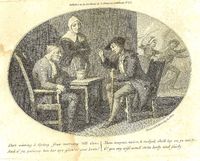Annotation:Hooly and Fairly: Difference between revisions
No edit summary |
No edit summary |
||
| Line 2: | Line 2: | ||
---- | ---- | ||
<p><font face="garamond, serif" size="4"> | <p><font face="garamond, serif" size="4"> | ||
'''HOOLY AND FAIRLY'''. AKA and see "[[Ballyhooley]]." Scottish, English; Air. England, Northumberland. A 19th century song, the style and chorus "borrowed from "The Drucken Wife o' Gallowa'," a song which first appeared in the '''Charmer''', a collection of songs, published in Edinburgh in 1751, but the authorship of which is unknown" ['''The Scottish Minstrel: The Songs of Scotland Subsequent to Burns''', 1882, p. 43]. The title appears in Henry Robson's list of popular Northumbrian song and dance tunes ("The Northern Minstrel's Budget"), which he published c. 1800. It is listed as an alternate title for the jig "[[Ballyhooley]]" in O'Neill's '''Dance Music of Ireland: 1001 Gems''' (1907). | '''HOOLY AND FAIRLY'''. AKA and see "[[Ballyhooley]]." Scottish, English; Air. England, Northumberland. A 19th century song, the style and chorus "borrowed from "The Drucken Wife o' Gallowa'," a song which first appeared in the '''[Yair's] Charmer''', a collection of songs, published in Edinburgh in 1751, but the authorship of which is unknown" ['''The Scottish Minstrel: The Songs of Scotland Subsequent to Burns''', 1882, p. 43]. The authorship of the "Hooly and Fairly" adaptation is known, however, and is attributed to dramatist Joanna Baillie (1762-1851). The title appears in Henry Robson's list of popular Northumbrian song and dance tunes ("The Northern Minstrel's Budget"), which he published c. 1800. It is listed as an alternate title for the jig "[[Ballyhooley]]" in O'Neill's '''Dance Music of Ireland: 1001 Gems''' (1907). | ||
[[File:hooly.jpg|200px|thumb|left|]] The caption to the picture at left is a verse from the song, and reads: | [[File:hooly.jpg|200px|thumb|left|]] The caption to the picture at left is a verse from the song, and reads: | ||
<blockquote> | <blockquote> | ||
| Line 23: | Line 23: | ||
<p><font face="garamond, serif" size="4"> | <p><font face="garamond, serif" size="4"> | ||
''Recorded sources'': <font color=teal></font> | ''Recorded sources'': <font color=teal></font> | ||
<br> | |||
<br> | |||
</font></p> | |||
<p><font face="garamond, serif" size="4"> | |||
See also listing at:<br> | |||
The Ballad Index [http://www.fresnostate.edu/folklore/ballads/McCST111.html]<br> | |||
</font></p> | </font></p> | ||
<br> | <br> | ||
Revision as of 04:18, 29 March 2014
Back to Hooly and Fairly
HOOLY AND FAIRLY. AKA and see "Ballyhooley." Scottish, English; Air. England, Northumberland. A 19th century song, the style and chorus "borrowed from "The Drucken Wife o' Gallowa'," a song which first appeared in the [Yair's] Charmer, a collection of songs, published in Edinburgh in 1751, but the authorship of which is unknown" [The Scottish Minstrel: The Songs of Scotland Subsequent to Burns, 1882, p. 43]. The authorship of the "Hooly and Fairly" adaptation is known, however, and is attributed to dramatist Joanna Baillie (1762-1851). The title appears in Henry Robson's list of popular Northumbrian song and dance tunes ("The Northern Minstrel's Budget"), which he published c. 1800. It is listed as an alternate title for the jig "Ballyhooley" in O'Neill's Dance Music of Ireland: 1001 Gems (1907).

The caption to the picture at left is a verse from the song, and reads:
She warring and flyting frae morning 'till e'en
And if ye gainsay her, her eye glow'rs sae keen;
Then tongue, neive & cudgel she'll lay on ye sairly,
O! gin my wife wou'd strike hooly and fairly.
Source for notated version:
Printed sources:
Recorded sources:
See also listing at:
The Ballad Index [1]
